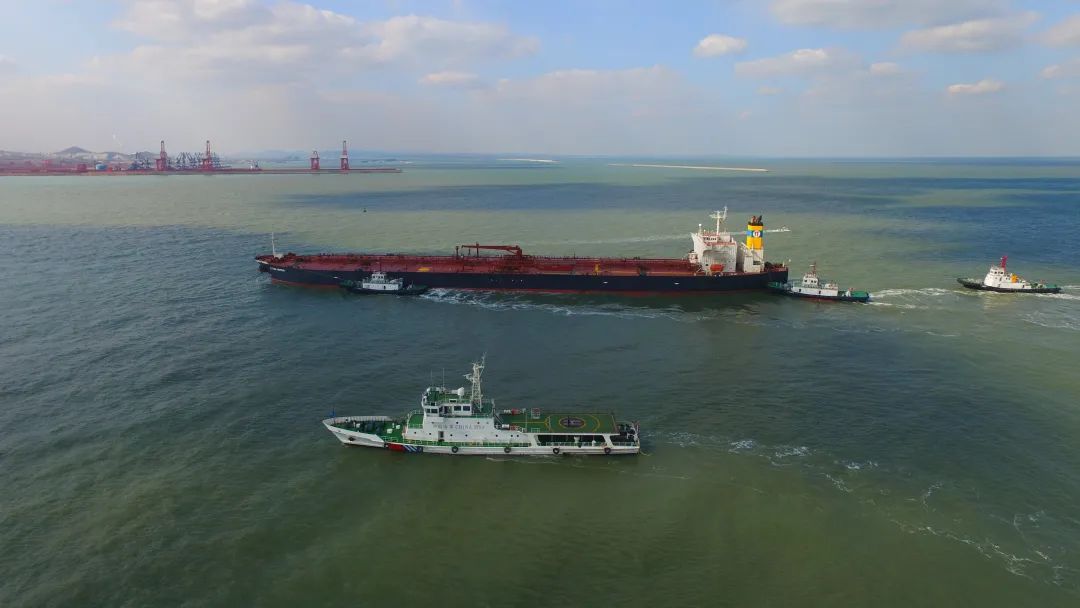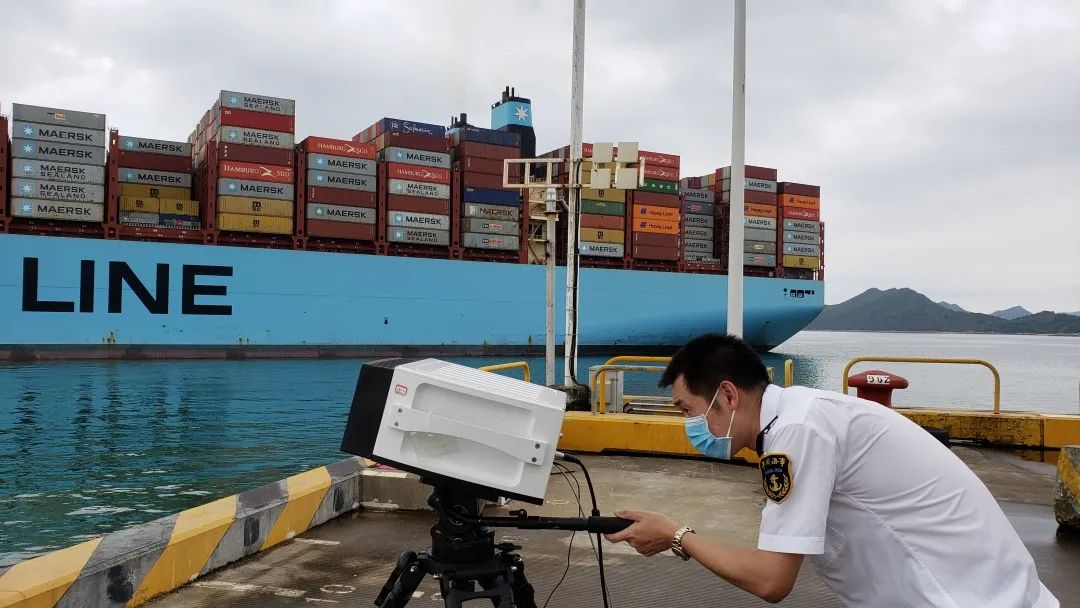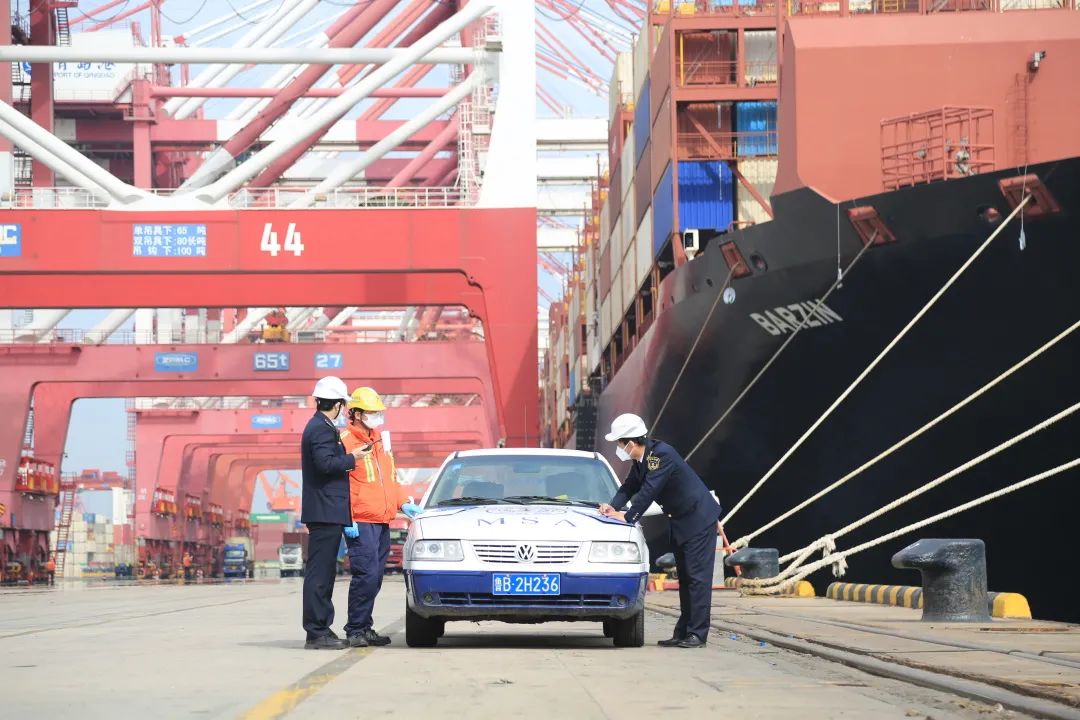Strong wind, wide sea and wide sky -- Maritime Practice of sustainable development
Without sustainable transport, there can be no sustainable development. How to make navigation safer? Cleaner waters? Make shipping easier? Make the global maritime governance system more mature? As an important part of the comprehensive transportation system and the main administrative law enforcement force on water, maritime people have been striving to provide strong security guarantee for the sustainable development of water transportation.
"Addition and subtraction" excellent environment
Reform to delegate powers, delegate powers, and improve regulation and services has invigorated the market
A few days ago, shandong port group within the west port area of 30 ton crude oil wharf, panama tanker "Scorpio" just came ashore, maritime sector staff began to "cloud embarkation" inspections for oil tankers, meanwhile, pipelines and port ship docking, open handling operation, haixun brigade of law enforcement officers also synchronous start on-site inspections.

Under the escort of Marine patrol boats, yantai West Port 300,000-ton crude oil terminal berthed large tankers for the first time. Zhou Hongyang perturbation
According to introducing, since 2019, influenced by international oil prices fall, China's crude imports increased dramatically, as an important energy channel, bohai bay port, west port area appears the phenomenon of serious delay unloading a ship and mooring ship 3-7, the average stay waiting time at more than a week, not only on the offshore oil transportation chain flow brings certain influence, Also to port, ship company brought bigger economic pressure. Reducing time limits, improving efficiency and optimizing the business environment have become urgent issues.
What the people want, the government wants. Yantai maritime authorities took the initiative to crack the problem, deepen the reform of "delegating control and service", explore and innovate the "chain" service scheme for super large tankers, integrate the examination and approval links of multiple departments, break through the information barrier, let the information run more, let the ship run less. The average time for each ship to apply for entry and departure approval is shortened from 1 day to 3 hours, which not only saves costs for each ship arriving at the port, but also greatly alleviates the phenomenon of oil tanker pressure in Yantai West Port area and ensures the smooth development of port bonded crude oil mixing business.
Not only the enterprises have benefited, but also the seafarers have tasted the benefits. These administrative counterparts frequently praised the reform measures of "deregulation and service" of maritime departments.
"In the past, if the shift is not handled during the rest time of the staff, it can not be handled. Now, the maritime government self-service station is convenient and fast, which solves the problem that the business can not be handled outside working hours." Guangzhou Nansha Marine Department area of a company's agent Mr. Chen said happily. As the first experiencer after the operation of Guangdong Marine Affairs Self-service station, Mr. Chen completed the whole process of filing through the self-service station in just a few minutes with the patient guidance and help of the staff.
Recently, the Maritime Safety Administration of the Ministry of Transport issued a "Notice on the Operation of Maritime government self-service Stations". Since September 1, 145 maritime government self-service stations have been fully operational in the Yangtze River trunk line area and the Guangdong-Hong Kong-Macao Greater Bay Area pilot area, including 118 stations in the Yangtze River trunk line and 27 stations in the Guangdong-Hong Kong-Macao Greater Bay Area pilot area. Mainly distributed in the key port area wharf, water service area, crew training school, maritime affairs center and station business demand, remote, inconvenient places. Completed in one machine can self-help maritime business to deal with the whole process, further optimize the maritime service "Internet + government affairs", expanding "not met" business coverage, all-weather "not close" to 365 days of e-government services, solve the crew can't deal with the difficulties of business pain points outside the working hours, to improve the masses of the people and the feeling of satisfaction.
Nie Yong, a crew member of Nanjing Oil Transportation Company, prints a certificate of qualification for inland River Ship crew at the self-service government service hall of Nanjing Maritime Administration in Nanjing, east China's Jiangsu Province, March 2, 2019. This is the first inland river ship crew qualification certificate issued by Jiangsu Maritime Safety Administration since the pilot reform of "multiple certificates in one" for ship and crew certificates, marking the end of the phenomenon of ship crew certificates, cumbersome handling and inconvenient carrying.
The reporter learned that before the reform of "multiple certificates in one", there were 11 certificates for ship crew, including 3 for ship registration, 6 for ship navigation qualification and 2 for crew qualification. It was very inconvenient to carry and keep them. Once they were lost, each certificate had to be reissued separately, and the formalities for different places were relatively cumbersome. Now 11 certificates are integrated into 3, namely, "Inland River Ship Registration Certificate", "Inland River Ship sailing Qualification Certificate", "Inland River ship crew qualification Certificate", and can generate electronic versions, at the same time from the source to eliminate fake certificates, expired certificates and other phenomena.
On October 8th, according to the application of Huangshi East Hubei Shipping Co., LTD., Nantong Maritime Safety Administration promptly arranged the audit team to carry out the audit of the ship "Suhaiao You 01" arriving at the port and issued the audit report on the same day, which saved a lot of time for the company's ship system audit and improved the safe operation efficiency of the ship. This audit is in accordance with the requirements of the Ministry of Transport maritime safety management system audit on October 1 since the implementation of the "national tongdo", Jiangsu province for the first time to different port ships to implement the safety management system audit.
The ship safety management system audit national office, since 1998, when the shipping company in our country is implementation of the ISM/NSM rules and establish safety management system, for the first time to cancel the ship commissioned audit, has been clear about the implementation can be used to inform commitment system for the interim safety management certificate, temporary safety management certificate issued by the time limit of the ship made a slash, The ship audit has been completed in one day.
It is understood that the ship safety management system audit national general office is the maritime department in order to better serve the counterpart, the current ship audit certification work further optimization. When the ship chooses to accept the audit in different places, license-issuing organs plan to ask the maritime safety Administration in different places to review, they do not need to go through the entrustment procedure, and do not need to wait for the other party to accept the entrustment. As long as the audit task is transferred from the information system, the maritime safety Administration at the berthing place will arrange the audit team, and the ship will be audited when it arrives at the port. It can reduce the deferral time of ships waiting for approval, improve turnover efficiency, save operating costs and reduce the burden of shipowners through the national general operation. This convenience measure will benefit an average of more than 2,000 ships every year, and just a temporary audit can save domestic shipowners hundreds of millions of yuan in costs every year.
At the same time, according to the actual situation, maritime authorities adjust maritime law enforcement authority, promote the international ship registration in the free trade zone, use the "Internet +" thinking to improve law enforcement efficiency and intelligence level, strengthen maritime support capacity building, promote the integration and integrated development of maritime navigation, etc., and earnestly serve the development of port and shipping enterprises. Experiences and practices that can be copied and promoted have emerged one after another, effectively promoting the orderly and convenient flow of factors in the shipping market.
Keep an eye on ship discharges
Promote green development of the shipping industry
On August 19, 2019, a ship moored at Danshuihe wharf in Xinsha, Guangzhou was detained by Guangzhou Maritime Safety Administration for suspected illegal use of substandard fuel oil. With the inspection report, Guangzhou Maritime Safety Administration investigated and punished the ship according to law. It is not a normal law enforcement action, but the guangzhou maritime bureau joint changshu maritime bureau, with the aid of shore-based ship exhaust monitoring results discovered and investigated in the navigation of ship the illegal use of high sulphur fuel behavior of a cross joint law enforcement, also is the new emission control policy, the domestic first attempt with the help of a remote monitoring equipment to carry out the emissions control area across the joint law enforcement. This also marks the maritime authorities in the ship supervision, law enforcement ability to further improve, can more effectively protect the air clean coastal China.

Law enforcement officers of shenzhen Maritime Safety Administration use infrared telemetry shore-based equipment to monitor ship exhaust. Peng Yongping perturbation
"Make navigation safer, let the waters cleaner" is the mission of maritime a consistent, for the implementation of the CPC Central Committee and the State Council about accelerate the construction of ecological civilization, lay the pollution prevention and control of battle and win the sky defense deployment, the Ministry of Transport of the ships in promoting the development of green shipping and have done a lot of work on energy conservation and emissions reduction.
In December 2015, the Ministry of Transport set up a ship emission control zone in the Bohai Rim (Beijing-Tianjin-Hebei), Yangtze River Delta and Pearl River Delta, aiming to control the emissions of sulfur oxides, nitrogen oxides and particulate matter from ships in China and improve the ambient air quality of coastal and riverfront areas, especially port cities. In November 2018, the Ministry of Transport issued the Implementation Plan for the Emission Control Zone for Ships, which expanded the existing emission control zone for ships. The adjusted vessel discharge control zone covers coastal waters, ports and inland river areas such as the Yangtze River.
In promoting the use of low sulfur fuel, China implemented the relevant provisions of the International Maritime Organization one year ahead of schedule, taking the lead in the world. In 2019, the Maritime Safety Administration of the Ministry of Transport issued the Implementation Plan for global Marine Fuel Sulfur Limit 2020, specifying that starting from January 1, 2020, international vessels shall not use fuel with sulfur content exceeding 0.5%m/m in waters under China's jurisdiction. In the same year, the Maritime Safety Administration of the Ministry of Transport issued the Guidelines for Supervision and Management of Atmospheric Pollution Emissions from Ships, instructing maritime administrative authorities at all levels to carry out supervision and inspection of the quality of Marine fuel oil for ships calling at ports, and investigate and punish ships using substandard fuel oil in accordance with laws and regulations.
In order to promote the supply guarantee of low-sulfur Marine fuel, the Maritime Safety Administration of the Ministry of Transport also actively promoted the relevant departments to implement export tax rebate policy for fuel oil refueled by international shipping vessels in China's coastal ports. On January 22, 2020, the Ministry of Finance, the State Administration of Taxation and the General Administration of Customs jointly issued the Notice on Export Tax Rebate for Fuel oil refueling by Vessels on International Voyages, specifying that "the policy of export tax rebate or exemption for fuel oil refueling by vessels on international voyages in China's coastal ports". In addition, the Maritime Safety Administration of the Ministry of Transport has actively implemented the requirements of "Internet + Supervision" and put into operation a unified national fuel reporting information system. At the same time, the legal rights and interests of shipping enterprises should be safeguarded.
"First of all, open the 'Ship shore power' wechat mini program, scan the QR code on the dock shore power, the ship can make an appointment to use shore power or submit shore power information such as electricity consumption." On the morning of September 10, Bi Deming, law enforcement officer of Zhangjiagang Maritime Safety Bureau, is introducing the use of dock shore electricity mini-program to the captain of "Long Hang Ji **" cargo ship berthing at the bonded port. It is understood that the small program is based on the Jiangsu Maritime Safety Bureau "ship E line" system of the new development of the ship shore power management information system.
"Ships used to be powered by diesel generators, which were noisy and smelly. When you land, you can use a dozen appliances on board at the same time, and it's safe, and it's much cheaper!" Boat said.
As the competent authority for the prevention and control of ship pollution, maritime authorities have been committed to promoting the use of clean energy such as LNG as fuel power and shore power for ships in port. In September 2020, Jiangsu Maritime Safety Administration, together with Jiangsu Provincial Department of Communications, issued the Implementation Plan for Promoting the Use of Shore Power by Ships and the Construction Standards for the Use and Promotion of Low-voltage Demonstration Areas and High-voltage Demonstration Sites of Shore power by Wharfships to jointly promote the construction and use of shore power. Policies such as exempting port electricity service fees within a specified period have been introduced to guide ships to actively use shore electricity. At the same time, we insist on strict law enforcement and urge the requirements of "connecting shore power immediately upon arrival at port" and "connecting shore power first and loading and unloading later". In addition, jiangsu maritime bureau in "water pollutants of the yangste river joint supervision and service information system" increased use shore power modules, ship, operators, regulators and other facilities to provide services, implementation can query before shipping port wharf can be automated docking after electric configuration information, port shore power, improve degree of shore power use is convenient. Thanks to these measures, from January to July this year, the Jiangsu section of the Yangtze River has 835 berths with shore power supply capacity, more than 110,000 ships relying on shore power, and 21.32 million KWH of electricity consumption, up 170 percent and 70 percent year-on-year respectively.
In addition to exhaust emissions, maritime authorities are also closely watching the discharge of sewage from ships. In 2020, the Ministry of Transport and other four ministries and commissions jointly issued the Plan on Pollution Control of Ships and Ports along the Yangtze River Economic Belt, and carried out a one-year campaign to control pollution from ships and ports along the trunk line of the Yangtze River. During this period, the Yangtze River Maritime Safety Administration vigorously carried out the "10th Five-year Promotion", and established and implemented three systems of "reward for reporting, punishment combined, and joint punishment for trust-breaking". Jiangsu Maritime Safety Bureau explored and established the mechanism of "10, 2 and 4 free", and on the basis of this experience, made all-out efforts to build the "Jiangsu mode" of ship pollution prevention and control, which is "full mobilization of port and shipping enterprises, full coverage of pollution control, full implementation of reception and disposal, and full chain of supervision services". Chongqing Maritime Safety Administration proposed to make efforts simultaneously from the two dimensions of ship and shore to implement "zero discharge" of water pollutants from ships, "zero generation" of air pollution from ships in port, and "zero disturbance" of noise pollution from ships in port, so as to achieve the "zero pollution" treatment target of ships.
Expand cooperation "Circle of Friends"
Building a global shipping community with a shared future
Cao Desheng, Director general of the Maritime Safety Administration of China, and Dudley McKinley Thomas, Liberian Ambassador to China, signed the Memorandum of Understanding on Maritime Cooperation between the Maritime Safety Administration of the People's Republic of China and the Liberian Maritime Safety Administration respectively on The sidelines of the second United Nations Global Sustainable Transport Conference on October 16. The signing of the MOU will help deepen and refine mutually beneficial cooperation in maritime security and environmental protection, and is of positive significance to china-Liberia and even China-Africa maritime cooperation.

Law enforcement officers of Qingdao Maritime Administration supervise and inspect ships at the wharf. Ma Guishan perturbation
In recent years, with the formulation of the United Nations 2030 Sustainable Development Goals, maritime technical cooperation aimed at "helping developing countries improve their maritime governance capacity" has attracted extensive attention from IMO member states. The Chinese Maritime Safety Administration has actively participated in the work of THE IMO Technical Cooperation Committee and undertaken a number of IMO technical cooperation projects. We will help developing countries jointly improve their maritime governance capabilities, actively share China's successful experience in maritime technology cooperation, and introduce China's proposals to continuously improve the level of global maritime technology cooperation.
The 71st session of the Technical Cooperation Committee of the International Maritime Organization (IMO) was held by video from September 20 to 24. For the first time, China submitted a proposal to the IMO Technical Cooperation Committee -- "Proposal on making full use of the MARITIME Technical Cooperation Center to implement the Comprehensive Technical Cooperation Program", which was mainly considered. The meeting think when reviewing a proposal to China, and Suggestions are very constructive, will help the IMO in global maritime technology cooperation further overall use of existing resources, improving the efficiency of technical cooperation projects, will be further into the IMO is developing maritime technical cooperation long-term strategy "capacity building ten years (2021-2030)", To guide future IMO technical cooperation.
On December 29, 2020, is in favor of the two foreign ministers jointly attended the tenth joint meeting of china-italy government committee, China's maritime bureau chief Cao Desheng with Italian infrastructure and transport port, sea and inland waterway infrastructure and transport secretary di matteo represent the maritime authority between the two countries signed a memorandum of understanding on the mutual recognition of seafarers certificate of cloud.
What are the benefits behind bilateral recognition of seafarers' certificates between the two countries? With the sino-italian cooperation results in seafarers' training and certification, is not only beneficial to the seafarers' employment in Italian ships in our country, at the same time also will be good for Italian seaman service in the cruise industry in our country, to further promote mutually beneficial cooperation in the field of transportation, the two countries promote bilateral economy more closely, enriching the connotation of the china-italy comprehensive strategic partnership. It is reported, in recent years maritime affairs department and 27 countries (area) sign unilateral or bilateral recognition seafarer certificate agreement.
On September 5, 2019, China and Singapore signed a memorandum of understanding (MOU) on e-cert for ships to promote the use of e-cert for registered ships of the two countries and strengthen bilateral cooperation in e-cert for ships. In 2020, "China-Singapore E-Cert Application Pilot Project" successfully completed ship e-cert test in Nansha Port of Guangzhou and Singapore port, and realized "single window" docking of maritime affairs between the two countries, becoming the world's first application case of e-cert on transnational ships.
International transport facilitation has facilitated closer cooperation, more convenient exchanges and greater convergence of interests between China and countries along the BELT and Road. In August of this year, the maritime and port authority of Singapore KeLiFen fully affirmed the "pilot program of application of new electronic certificate" this fruitful cooperation, and says it will actively promote cooperation memorandum signed seafarers electronic certificate of competency, seeking to forge a clear regional maritime logistics cooperation model, to promote the construction of the new international sea trade channels, To ensure the stability of the global logistics supply chain and promote the continuous deepening of the all-round cooperative partnership between the two countries.
Since the belt and Road Initiative was put forward, the depth and breadth of maritime cooperation between the Maritime Safety Administration of the Ministry of Transport and international maritime affairs has been greatly enhanced. The Maritime Safety Administration of the Ministry of Transport has actively communicated with the International Maritime Organization (IMO), international Association of Navigational AIDS (IAWA) and other international organizations, and strengthened cooperation with countries along the Belt and Road in maritime transport safety through such platforms as the Asia-Pacific Maritime Directors' Meeting, China-Asean Maritime Consultation Mechanism meeting and ASEAN Maritime/Maritime Working Group Meeting.
Based on lancang-Mekong Maritime safety supervision needs and cooperation intentions of Laos, Myanmar and Thailand, maritime Safety Administration of the Ministry of Transport, with the support of China-Asean Maritime Cooperation Fund, launched the "Lancang-Mekong Maritime Safety Supervision Facilities Construction and Management Project" in 2016. Plans to jinghong city in China to Laos post bourgogne state along the lancang - Mekong river navigable sector, the construction of eight AIS (automatic identification system) base station and eight VHF (very high frequency) base stations, and development for Laos Burma and Thailand four maritime safety regulation and emergency rescue system, the realization of the wireless communication signal coverage of key segment waters. Upon completion of the project, navigation safety in the waters will be greatly improved and contribute to the building of a lancang-Mekong community with a shared future.
Source: China Water Transport News
Original title: "Strong wind, Wide Sea and Wide Sky -- Maritime Practice of Sustainable Development"
 Tel:0532-83870071
Tel:0532-83870071  Email:tiger.du@lo-scm.com
Email:tiger.du@lo-scm.com


